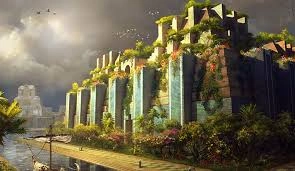The Hanging Gardens of Babylon: Real or Legend
Brie 21 Jun, 2019Often counted among the Seven Wonders of the Ancient World, the Hanging Gardens of Babylon have long captivated historians and travelers alike. Described as a lush oasis rising high above the Mesopotamian plains, they allegedly showcased terraced gardens, elaborate irrigation systems, and exotic plants. But the question remains: were these gardens actually real, or are they simply the stuff of myth and legend?

1. Historical Descriptions
Ancient writers such as Berosus (a Babylonian priest) and Josephus (a first-century Romano-Jewish scholar) spoke of an opulent garden that was said to have been built by the Babylonian king Nebuchadnezzar II for his wife, who missed the green hills of her homeland. These accounts detail tiered terraces overflowing with trees, flowers, and cascading water.
2. The Mystery of Their Location
Modern archaeological excavations around Babylon in present-day Iraq have uncovered remarkable structures, but there’s no definitive evidence of the famed hanging gardens. Some scholars propose that the actual site may have been located hundreds of miles away in Nineveh, the capital of the Assyrian Empire, while others argue the gardens may never have physically existed at all.
3. Engineering Marvel or Myth?
If the gardens did exist, they would have been a remarkable feat of engineering, especially given the arid conditions of Mesopotamia. The gardens supposedly employed sophisticated irrigation techniques using channels and lifts to carry water from the Euphrates River up multiple terraces. Historians suggest that maintaining such a system in the desert required constant oversight and significant resources.
4. Theories and Interpretations
Several hypotheses seek to explain the legend of the Hanging Gardens:
- Symbolic Description: Some posit that the gardens were less about reality and more about reflecting Babylon’s grandeur and Nebuchadnezzar’s perceived divine power.
- Misattribution of Architecture: Evidence might exist in remnants of other impressive structures, which were later mythologized into a grand, green wonder.
- Lost in Translation: Ancient texts could have exaggerated natural elements or architectural terraces, leading to the concept of a lush, “hanging” paradise.
5. Cultural and Artistic Legacy
Regardless of their existence, the Hanging Gardens continue to inspire art, literature, and popular culture. They have been depicted in:
- Classical paintings featuring soaring terraces draped with vines.
- Modern fantasy novels that imagine the gardens filled with mythical flora and fauna.
- Video games where “hanging” or terraced landscapes evoke the grandeur of Babylon’s fabled past.
6. Visiting Babylon Today
Present-day Babylon is an archaeological site in Iraq that offers a glimpse into Mesopotamian civilization. Though no confirmed remains of the Hanging Gardens exist, visitors can still explore partially reconstructed ruins, including portions of Nebuchadnezzar II’s palace and the famed Ishtar Gate. These sites connect modern explorers to a time when Babylon was one of the world’s most significant power centers.
7. Conclusion
Whether the Hanging Gardens of Babylon were a literal wonder or a romanticized legend remains an enduring puzzle. The possibility of a grand, oasis-like sanctuary in the heart of an ancient desert city continues to capture our collective imagination. For historians, travelers, and dreamers alike, the tale of the Hanging Gardens serves as a testament to humanity’s eternal fascination with architectural achievement, natural beauty, and the elusive line between fact and myth.